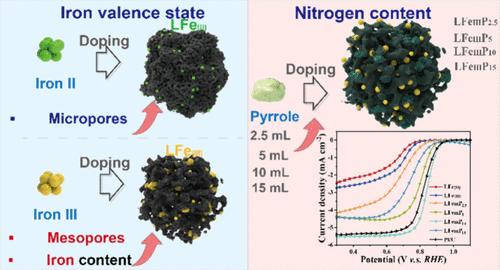Fe-N-C催化剂氧还原反应性能增强机理的探讨:铁价态和氮含量的影响
IF 8.2
2区 材料科学
Q1 MATERIALS SCIENCE, MULTIDISCIPLINARY
引用次数: 0
摘要
优化氧还原反应(ORR)的非贵金属催化剂对推进能量存储和转化技术至关重要。研究了铁价态和氮前驱体含量对木质素基Fe-N-C催化剂理化性能和电化学性能的影响。采用不同价态铁源和不同吡咯含量合成催化剂。结果表明,掺杂铁(II)提高了碳材料的微孔率和比表面积,而掺杂铁(III)提高了碳材料的介孔率和铁含量。XPS和拉曼光谱证实了制备的LFeIIIPx催化剂中Fe-Nx活性位点的成功结合。电化学测试表明,LFeIIIP10表现出最高的ORR活性,在半波电位(E1/2)和极限电流密度(JL)上超过了商用Pt/C。采用LFeIIIP10空气阴极的直接甲酸盐燃料电池(DFFC)的最大功率密度为24.7 mW cm-2,比采用Pt/C阴极的燃料电池高32%。该研究强调了调整铁价态和氮水平对开发高ORR性能、高成本效益的Fe-N-C催化剂的关键作用,为未来设计能源应用中的非贵金属催化剂提供了有价值的见解。本文章由计算机程序翻译,如有差异,请以英文原文为准。

Understanding the Mechanism of Fe–N–C Catalyst Oxygen Reduction Reaction Performance Enhancement: The Impact of Iron Valence State and Nitrogen Content
Optimizing non-noble catalysts for the oxygen reduction reaction (ORR) is crucial for advancing energy storage and conversion technologies. This study investigates the influence of iron valence states and nitrogen precursor contents on the physicochemical properties and electrochemical performance of lignin-based Fe–N–C catalysts. Catalysts are synthesized using different valence iron sources and varying pyrrole contents. The results reveal that iron(II) doping increases microporosity and specific surface area, while iron(III) doping enhances mesoporous and iron contents of the carbon materials. XPS and Raman spectroscopy confirm the successful incorporation of Fe–Nx active sites in the as-prepared LFeIIIPx catalysts. Electrochemical tests demonstrate that LFeIIIP10 exhibits the highest ORR activity, surpassing commercial Pt/C in half-wave potential (E1/2) and limiting current density (JL). The direct formate fuel cell (DFFC) with an LFeIIIP10 air cathode achieves a maximum power density of 24.7 mW cm–2, 32% higher than that with a Pt/C cathode. This study highlights the critical role of tailoring iron valence states and nitrogen levels to develop high ORR performance, cost-effective Fe–N–C catalysts, providing valuable insights for the future design of non-noble metal catalysts in energy applications.
求助全文
通过发布文献求助,成功后即可免费获取论文全文。
去求助
来源期刊

ACS Applied Materials & Interfaces
工程技术-材料科学:综合
CiteScore
16.00
自引率
6.30%
发文量
4978
审稿时长
1.8 months
期刊介绍:
ACS Applied Materials & Interfaces is a leading interdisciplinary journal that brings together chemists, engineers, physicists, and biologists to explore the development and utilization of newly-discovered materials and interfacial processes for specific applications. Our journal has experienced remarkable growth since its establishment in 2009, both in terms of the number of articles published and the impact of the research showcased. We are proud to foster a truly global community, with the majority of published articles originating from outside the United States, reflecting the rapid growth of applied research worldwide.
 求助内容:
求助内容: 应助结果提醒方式:
应助结果提醒方式:


